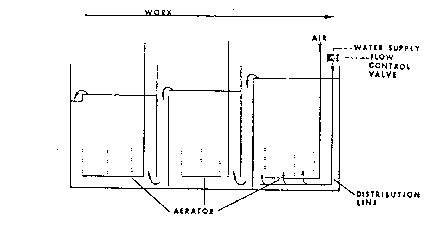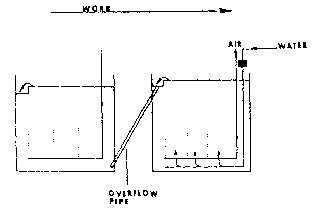

In counter-current rinsing, the rinse water is circulated through a series of rinse tanks. Fresh water is fed into the rinse tank farthest from the process tank and overflows, inturn, to the rinse tank closest to the process tank. The work piece then, is dipped in the least pure water first and the cleanest water last. An example of a three stage counter-current rinse system is shown below:

Counter-current rinsing uses significantly less water than a single flowing rinse. Typically, two counter-current rinse tanks can reduce water use by 90 to 97%. The addition of a third tank will reduce water use by 95 to 99%. A fourth rinse tank will further reduce water use, however the additional small quantity of water saved may make it uneconomical.
To illustrate the water saving from using counter-current rinsing lets examine a typical plating operation using a Watts Nickel Bath. Assume the bath solution contains 270,000 mg/l total dissolved solids and the final rinse can contain no more than 40 mg/l dissolved solids. A single rinse tank would need about 6,750 gallons of fresh feed water for each gallon of plating solution dragged into the rinse tank. A two stage counter-current rinse tank would need only 82 gallons of water for each gallon of drag-out solution. While a triple stage rinse tank system would need only 18 gallons of fresh water feed.
Counter-current rinse tank systems can be purchased new or retrofitted into an existing tank or series of tanks. In most cases the system will consist of a single tank divided into a series of compartments. Water overflows from one compartment and enters the next through a submerged weir. As in all properly designed rinse tanks, air agitation and flow control valves are used. Such a system is illustrated in the previous figure. These systems can be purchased new and ready to install or an existing rinse tank can be modified.
Another approach is to place a second or third rinse tank into the process line and gravity feed or pump the rinse water from the last rinse tank to the first. Only a few inches of head is needed to gravity feed the water. If it is not possible to provide the required head then pumps can be used to circulate the water. Either small submersible pumps or a simple air lift pump (as described in the May, 1982 issue of Plating and Surface Finishing) can be used. Such a system is shown below:

|
|
Counter-current rinsing is not without its draw backs. One problem is the high cost of purchasing the systems. Another is that space limits the use of this technique as extra floor space is needed for the additional rinse tanks.
The cost of a new 600 gallon two stage counter-current rinse system is about $1,300 while a 900 gallon three stage system is about $1,800.
Installation costs, while very site specific, are estimated to be about $500. If extra tanks are available on-site then the cost of constructing a rinse system will be significantly less. For example, a gravity fed system using two separate tanks can cost as little as $120 to make. The costs includes $60 for an aerator, $10 for a mechanical flow control valve and $50 for 1" PVC pipe and necessary connectors for the overflow. The actual cost may be significantly higher depending on the modifications made to the rinse tanks.
The typical total cost of purchasing and installing a two stage countercurrent rinse system is about $1,800. A three stage system would be about $2,300.
There are no direct operational costs associated with these techniques. Though, they should be included in the facility's routine inspection and maintenance program.
The pay back period for installing a counter-current rinse tank will depend on the quantity of water saved and the raw water costs. For example, if a two stage system is used to reduce the water flow from 6 gpm to 0.6 gpm, and the water and sewer charges are $2/1,000 gallons, the pay back period will be about 70 weeks. After this initial pay back period the system will reduce operating costs by about $1,350 per year, through water savings.
In addition to these direct cost savings, a water conservation program can reduce the capital cost of any required end-of-pipe wastewater treatment system. A rough "rule of thumb" is that a precipitation system costs about $2,000 per gallon of flow per minute. Thus a substantial reduction in water flow can produce corresponding savings in treatment system costs. However, small or token reductions will yield very little, if any, savings.
Selected References